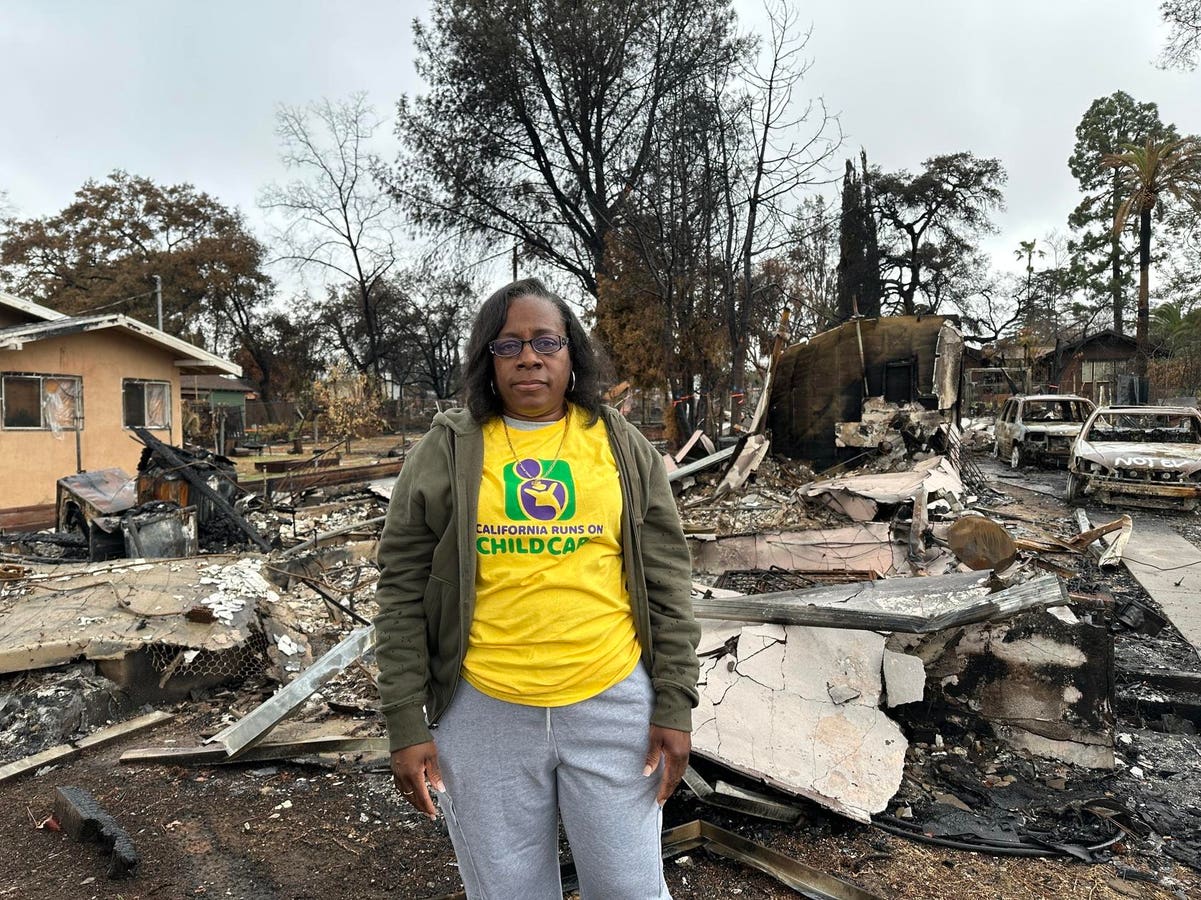Actress and author Tori Spelling and her daughter Stella McDermott have opened up about their struggles with eczema. (Photo: Courtesy of Arcutis Biotherapeutics, Inc.)
Courtesy of Arcutis Biotherapeutics, Inc.
You could say that it’s worth spelling out how tough having eczema can be. Actress and author Tori Spelling and her daughter Stella McDermott recently talked to me about their struggles with eczema. Eczema encompasses a group of inflammatory skin conditions that many people are still not very clear about, so to speak—even though eczema affects an estimated 10% to 20% of children and 2% to 10% of adults around the world, according to the National Eczema Association. Spelling and McDermott also discussed their partnering with Arcutis Biotherapeutics, Inc. for “Free To Be Me,” a campaign to raise awareness and reduce stigma around inflammatory skin conditions in general.
Spelling Wasn’t Fully Aware Of Eczema Before She Started Experiencing It
A big reason for the many misconceptions that exist about eczema is that people don’t tend to talk about the condition openly. It’s not as if the typical answer to “how you doing” is “my eczema is flaring up, so very itchy.” No, instead, the norm frequently is to suffer in silence.
“I actually talk about a lot of things in my personal life and pride myself up on being able to be open and share with people,” Spelling explained. “However, my journey with eczema is something I never spoke out about. And to think about it, it’s because I felt shame behind it, and I was embarrassed.” She continued by saying, “I also didn’t get eczema till I was an adult, which I never understood because when I heard of eczema, I always thought of it as a childhood skin condition, which is what Stella went through.”
Spelling, now 52 years of age, also stressed what may have brought out the eczema back when she was 31—namely lot of stress. “I was going through one of the most stressful times in my life,” she recalled. “I was going through a breakup, I was simultaneously creating a new show, and the stress factors just literally came out on my skin.” So, she could add eczema to her list of things causing stress.
To say that the symptoms were bothersome would be only scratching the surface of what happened. As Spelling described, “It went from such severe itching on my arms and hands, but I couldn’t see anything, to actually manifesting in pain. I didn’t know if it was welts or a rash or what it was.” Then came the “rash” decision. “At the time, we actually had to shut down production and a doctor came in and diagnosed me with eczema.” That show-stopper showed how much eczema can ”show” enough affect your daily work and personal life.
I’ve already covered in Forbes last month how eczema is 15th leading cause of disability around the world among non-fatal diseases and how lack of awareness and knowledge of eczema often delays its diagnosis. It’s unclear what causes eczema. But one thing’s clear: the various possible manifestations of eczema on the skin—such dryness, itchiness, rashes, bumps, swelling, flakiness, leathery thickening, scaliness, crustiness and cracks—over various parts of your body can really interfere with daily living in different ways.
Spelling’s Daughter Has Had Eczema Since Early Childhood
Speaking of potentially flaky skin, I also wrote about how eczema can be kind of snowflaky, in that no two cases are exactly the same. There can be significant variability in when and how eczema presents as well as the severity of symptoms. Look no further than Spelling’s household. “With Stella, it’s been a different journey, and that’s when I started to learn more, that it is genetic.” Spelling said. “So I tell her you got a lot of good things from your mama, eczema is not one of them, but we’re on this journey together.” Spelling added, “She has been suffering with the skin condition since she was a small child like she’ll even say it’s before she even has memory of it.”
The now 17 years of age McDermott concurred, “I just really remember it being an issue in elementary school and it just got worse from there, especially in middle school when I dealt with a lot of bullying from it.” McDermott added, “Just a lot of like kids that age not understanding what it was and thinking, oh, is it contagious? Am I going to get it from you?”
Spelling spoke about the frustration of not knowing what to do about McDermott’s condition: “From a young age, as a little girl, toddler, she had eczema on her arms, on her face, on her scalp, and just from before she’ll answer, but I didn’t know what was happening. I didn’t know how to help her. Baths would send her screaming in pain.”
With relatively few people talking openly and frankly about eczema, it can be a challenge finding information about how to deal with the condition. And what information is out there can be a big swing and a “mis,” as in misinformation. “Once I was diagnosed, once she was diagnosed, the information didn’t seem consistent at the time,” Spelling lamented. “So, as a parent, it was very hard to know what to do. And like Stella said, you just kind of internalize it.”
Spelling And McDermott Tried Many Different Eczema Treatments
With little consistent guidance, “you have to find solutions on your own,” in McDermott’s words. “I’ve tried a lot of different things and a lot of different steroid creams that just honestly made it worse and just made my skin drier and more inflamed.”
I’ve also covered in Forbes the different types of possible treatments. They range from avoiding anything that may cause flare-ups like that pet capybara of yours to keeping your skin moisturized to antihistamines to phototherapy to steroid creams to immunosuppressant medications. Different levels of severity may require different approaches.
Each of these can have their strengths and drawbacks, such as having to part ways with that capybara. What works for one person may not work for another. For example, steroid creams can be quite effective for some but actually make things worse for others. What works for a while may at some point stop working. Therefore, it is important to work with a doctor to help choose the best regimen for you.
Spelling and her daughter went through many different possibilities. Spelling said of her daughter, “We had to bathe her in oatmeal in a washcloth. It was the only way to get down the pain and inflammation. But, you know, we tried everything.” She went on to say, “I tried to find over-the-counter products. The creams then all had steroids in them. So we would try one after another, but as a mom, I did not feel right using steroid creams over and over. It didn’t feel like a long-term solution to something that there would never be a cure for because she has eczema.” Spelling added, “It got really exhausting, I think, and not knowing if there would ever be something that would help.
For Spelling And McDermott Found Something That Made A Difference In The Eczema
Jennie Garth and Tori Spelling co-host a weekly 912OMG podcast. (Photos by Emily Assiran/Getty Images for 90’s Con)
Getty Images
They may have tried lots of things, A through Z, but something that begins with a “Z” seemed to make a difference. “Our dermatologist said, you should try Zoryve and see if it works for you,” Spelling recalled. Zoryve is a topical medication made by Arcutis Biotherapeutics, Inc., to treat inflammatory skin conditions like eczema and seborrheic dermatitis. It doesn’t have steroids in it. Instead, the active ingredient in Zoryve is roflumilast, which may look a little like ROFL but is not about “rolling on the floor laughing.” No, roflumilast acts by inhibiting the activity of phosphodiesterase-4 or PDE4. Most of the cells involved in the inflammatory response seen in eczema produce PDE4. That PDE4 helps break down cyclic-3’,5′-adenosinemonophosphate otherwise known as cyclic AMP. Inhibiting PDE4 then increasing the amount of cyclic AMP in these cells, which seems to reduce the inflammation promotion action.
“When she started using Zoryve, in weeks, she and I saw a change, and it was like, ‘Oh, my goodness,’” Spelling related. “Again, this is what has personally worked for us. But seeing that change when your child lights up as something finally worked for her, it was amazing.”
One big difference between when Spelling first was diagnosed with eczema and now is the big T: time. “Where we are right now is very different than we were 10 years ago,” pointed out Adam Friedman, MD, FAAD, Professor and Chair of Dermatology at The George Washington University School of Medicine and Health Sciences. “Just 10 years ago, there were no FDA-approved medications for even moderately severe disease, and our topical options were very limited, and then that, in turn, translated into not having readily accessible quality assured information online.” Friedman explained that topical steroids are used for all sorts of things and not very specific to the mechanisms involved in eczema. He went on to say, “I think that we have entered into really an incredible time where we have targeted therapy meant for a particular condition.”
Friedman did caution, “Nothing comes with zero risk. So Zoryve, for example, headache, nausea vomiting, diarrhea and pain can always happen though it’s rare.” This helps reiterate a key point: what works for one or even two people may not necessarily work for you or others. So don’t go thinking that “If it worked for a star of Beverly Hills, 90210, The House of Yes and Scary Movie 2 and her daughter, it should work for me.” Again, they key is to get guidance from a real life doctor with the proper training, credentials and experience who knows you and your skin well. Friedman summarized, “The main message is mo options, less problems.” And, yes, he did specifically say “mo.”
Well, keeping her eczema under control is helping Spelling do mo and mo stuff these days. She is active with her weekly podcast misSPELLING, which is play on her last name, not that you’ve ever heard such a pun. She also co-hosts the also weekly 9021OMG podcast with fellow 90210 star Jenny Garth. Her daughter, Stella, meanwhile, says, “I’m just finishing off my senior year and enjoying the time I have before prom, graduation, college.”









